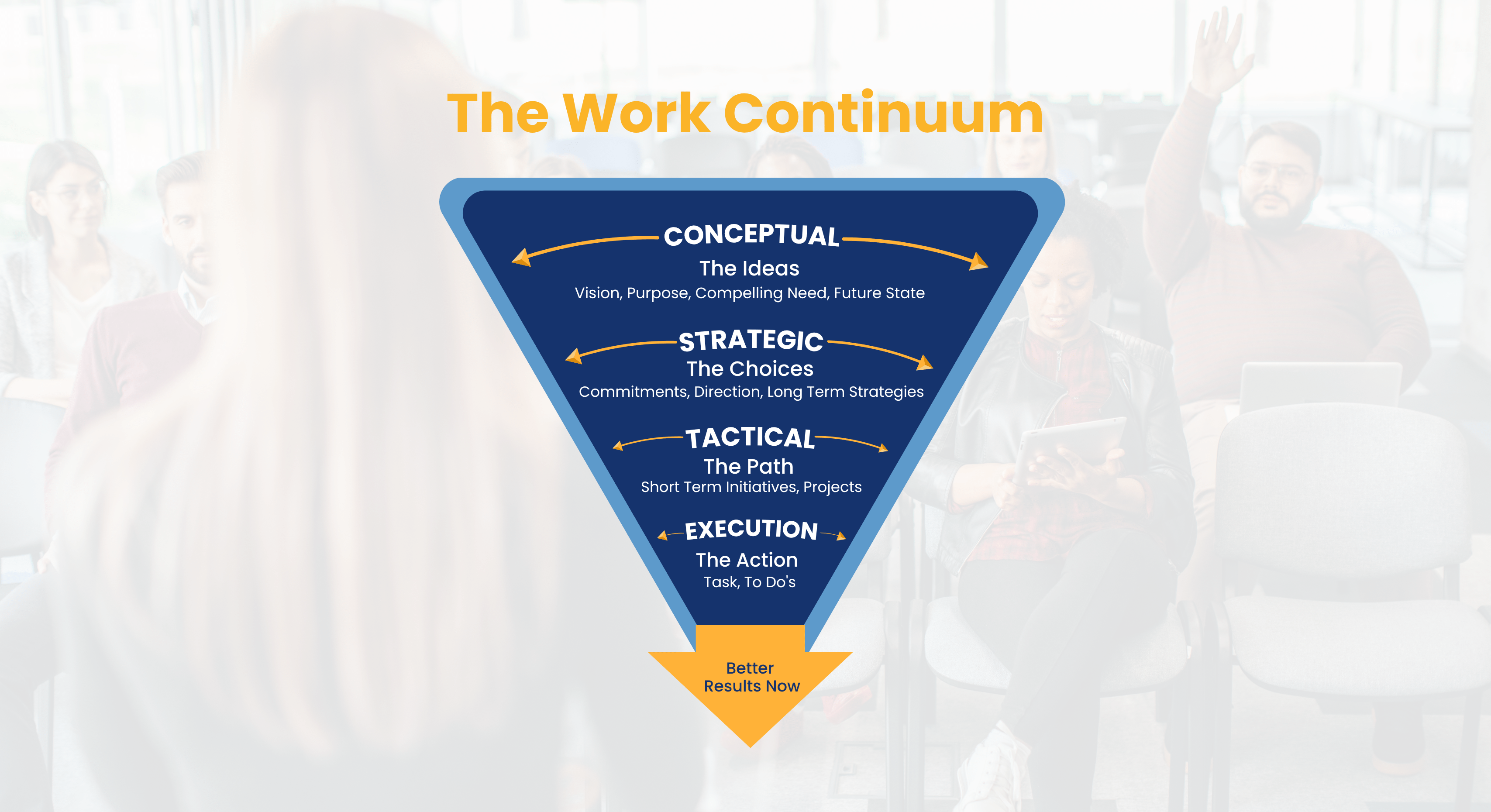From Vision to Execution: How the Work Continuum Drives Real Results
In many organizations, the biggest obstacle to progress isn’t a lack of ideas —it’s a disconnect between those ideas and the day-to-day work.
You’ve probably felt it before. A strategic plan is rolled out with enthusiasm, only to stall six months later. A compelling vision is discussed in leadership meetings, but never seems to touch the ground floor. Or teams are heads- down executing tasks, without a clear sense of why the work matters.
At Work Excellence, we define the Work Continuum as the flow from conceptual thinking to strategic choices, down to tactical planning, and ultimately to execution. Each layer plays a distinct role, but it’s the connection between them that fuels alignment, clarity, and results.
Understanding the Work Continuum
Let’s break it down:
1. Conceptual Work – Vision, Purpose, Compelling Need
This is where it starts. Big-picture thinking. Why does the work matter? What future are we creating? What is the compelling need driving change?
Where teams get stuck: Endless brainstorming, vague purpose statements, or misalignment on “why” work is being done.
Work Excellence Insight: Clarify the Work Direction—the purpose behind the work. Turn abstract ideas into clear, shared statements that anchor everything else.
2. Strategic Work – Choices, Commitment, Long-Term Direction
This is about making decisions that move the concept forward. What will we say “yes” to? What must we say “no” to? This is where direction is set.
Where teams get stuck: Analysis paralysis, overplanning, fear of commitment, or disconnected strategies that aren’t tied to actual resources or capabilities.
Work Excellence Insight: Use Work Systems to define how value will be created—visually and realistically. Strategic clarity thrives on knowing what’s in motion and what it takes to execute it.
3. Tactical Work – Short-Term Projects, Initiatives, Milestones
Now we’re planning how to move forward. What initiatives will we launch this quarter? What resources are needed? What are the milestones?
Where teams get stuck: Project overload, misaligned priorities, or unclear ownership of tactical initiatives.
Work Excellence Insight: This is where Work Improvement becomes essential. Tactical work isn’t just about launching projects—it’s about learning from them. Use Work Improvement to create short feedback loops, test ideas, and adjust in real time. When improvement is built into your process, tactical efforts stay agile, aligned, and connected to strategic goals.
4. Execution Work – Tasks, To-Dos, Daily Action
This is the work in motion. Emails, meetings, deliverables, deadlines.
Where teams get stuck: Overwhelmed teams, competing priorities, confusion over what’s most important, or just burnout from nonstop doing without seeing impact.
Work Excellence Insight: Work Routine and Work Measurement work hand in hand to make execution meaningful. The Work Routine provides a consistent rhythm for reviewing progress, adjusting plans, and staying aligned. Work Measurement ensures you’re not just busy – you’re making measurable progress toward defined outcomes. Together, they help teams track what matters, reflect regularly, and maintain momentum that’s grounded in purpose.
Where Are You Getting Stuck?
Every organization has strengths – and sticking points – somewhere on the continuum. The key is building flow between all four types of work, not just strength in one area.
Let’s reflect:
- Is your organization full of great ideas but slow to act?
- Are you stuck in execution mode with no clear direction?
- Do your teams understand how their daily work connects to the big picture?
If the answer to any of these is yes, it’s time to bring visibility to the continuum and get back in sync.
Team Exercise: Rate & Reflect
Use this quick rating system in your next leadership meeting:
- Green – we’re strong here.
- Yellow – We’re making progress, but it’s inconsistent.
- Red- This is a friction point or outright barrier.
Then ask your team:
- In which type(s) of work do we excel? Why?
- Where do we get stuck most often?
- Are we making strategic decisions – or just running projects?
- Do our conversations around purpose lead to action, or spin in circles?
- How can we apply the Work Excellence Method to restore flow?
From Reflection to Action
Here are a few simple steps to improve flow across the Work Continuum:
- Revisit your Work Direction. Is your purpose clear, relevant, and widely understood?
- Visualize your Work Systems. Do you know how value is created across departments?
- Make improvement intentional. Are you capturing lessons from what’s working (or not) and turning those into better approaches going forward?
- Track with purpose. Are you measuring what matters – or just reporting data?
- Build in routine. Are you regularly checking and adjusting to stay aligned?
These aren’t just abstract exercises – they’re the foundation of sustainable, aligned execution. When your organization flows smoothly from idea to action, progress feels natural. Results follow.
Let’s Build the Bridge Together
The Work Continuum isn’t just a concept – it’s a practical tool to help your team operate with more clarity, confidence, and cohesion.
If you’re ready to reduce the friction and reconnect your vision to your execution, let’s start the conversation. We’ll help you assess where you stand and build a tailored plan to create real movement through the Work Excellence Method.
Reach out to us or learn more about the Work Excellence Method here.

